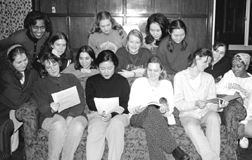The University Record, February 25, 1997
NSF recognizes U-M’s effort to integrate research, undergrad education

Chemistry Prof. Henry Griffin (left) discusses results and procedures in his laboratory with students involved in the Undergraduate Research Opportunity Program. Each of the four students Griffin works with is responsible for one piece of a project and for reporting results of their work to the rest of the group. Students working with Griffin are Keith Loop (second from left), Christopher King, Kelly Ries and Michael Muse.
Photo by Rebecca A. Doyle
By Deborah Gilbert
News and Information Services
The University has received one of 10 Recognition Awards for the Integration of Research and Education (RAIRE) from the National Science Foundation (NSF).
The award, which recognizes the University’s commitment to integrating research and undergraduate education, is for $500,000 over three years.
“I am pleased that the National Science Foundation has identified Michigan as one of a handful of exemplary research universities, each recognized not only for general excellence in science and engineering education but also for noteworthy achievements unique to the institution,” says President Lee C. Bollinger.
Michigan’s RAIRE award, specifically for Michigan’s Undergraduate Research Opportunity Program (UROP) and the Women in Science and Engineering-Residential Program (WISE-RP), recognizes the U-M for fostering student diversity in undergraduate science and engineering education by engaging students in research experiences and learning communities.
“The Undergraduate Research Opportunity Program and WISE-RP have accomplished two goals that are critical to the University’s mission: increasing diversity among students in the sciences and engineering—a goal expressed in the Michigan Mandate and the Michigan Agenda for Women—and the goal of engaging undergraduate students in the U-M research community. The result has been not only enhanced retention rates among students at risk but also the creation of research opportunities that are of tremendous benefit to all capable students,” says Homer A. Neal, vice president for research and former interim president.
Undergraduate Research Opportunity Program
UROP is the largest U-M undergraduate research program. It was launched by LS&A in 1989 with 14 minority student and faculty research partnerships and now has 750 students and 450 faculty from across the University. More than 2,500 students have participated in the program since its inception. Although UROP now includes first- and second-year students of all backgrounds, it maintains an emphasis on minorities (40 percent) and women in science (25 percent).
“The centerpiece of UROP is the student-faculty research partnership where students become engaged in cutting edge laboratory research, collaborate on new books, help create instructional technology, or even participate in the development of a new course,” says Sandra R. Gregerman, UROP director.
UROP students are assigned peer advisers—UROP alumni who help students find research projects, monitor progress and assist in student-faculty communication. “Peer advisers also run biweekly sessions in which students in similar research fields can discuss and present their projects and meet guest researchers who discuss issues ranging from ethics to emerging research trends,” Gregerman adds.
As a result of their research experience in their first and second years, UROP alumni often have access to other research opportunities such as the Fogarty Minority International Research Training Fellowships that fund undergraduate student summer research projects in South Africa, Chile, Bolivia and China.
Women in Science and Engineering-Residential Program
 Seated on a couch in Couzens Residence Hall graduate students in some of the science and engineering disciplines talked with undergraduate women about experiences they had as students in disciplines that are traditionally male-dominated. From left, the graduate students are Carla Barret, nuclear engineering and radiological sciences; Hyun Mee Oh, business; Heather Lee, genetics counseling; and Diana Rumpel, public health.
Seated on a couch in Couzens Residence Hall graduate students in some of the science and engineering disciplines talked with undergraduate women about experiences they had as students in disciplines that are traditionally male-dominated. From left, the graduate students are Carla Barret, nuclear engineering and radiological sciences; Hyun Mee Oh, business; Heather Lee, genetics counseling; and Diana Rumpel, public health.
The Women in Science and Engineering-Residential Program focuses on retaining women in the sciences and engineering by creating a supportive academic environment outside the classroom.
WISE-RP houses first- and second-year women students with similar academic interests on a floor in Couzens Residence Hall. “Our purpose is to reduce the sense of isolation many women feel when they are one of only a few women in a science or engineering class,” says Cinda-Sue Davis, director of the Universitywide WISE program at the Center for the Education of Women.
“Bringing these young women with similar interests together in a small, close-knit living environment facilitates the formation of supportive peer groups—both academic and social. The women share an intellectually stimulating and supportive environment and join in social events. They also participate in an outdoor challenge rope course in the fall and a retreat on team-building and communication skills in the winter.”
WISE-RP, a collaborative project between WISE and the Housing Division, began in 1993-94 with 57 students and now includes about 110 women. The students participate in formal and informal collaborative learning study groups in mathematics, chemistry and physics. The women also attend academic and career workshops and have the opportunity to participate in research partnerships with faculty.
The RAIRE award, which will be administered by the Office of the Vice President for Research, will allow UROP and WISE-RP jointly to expand undergraduate research opportunities and develop descriptive materials that can be used by other colleges and universities to develop their own undergraduate research programs.

